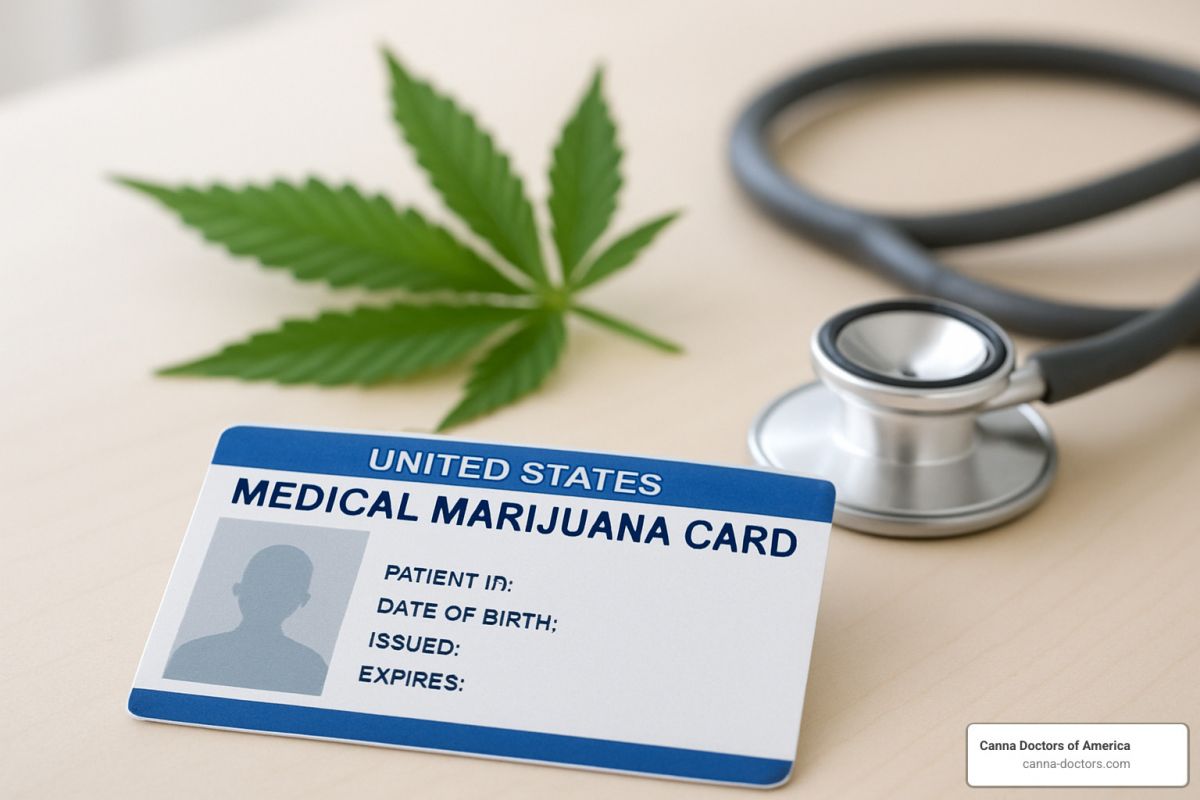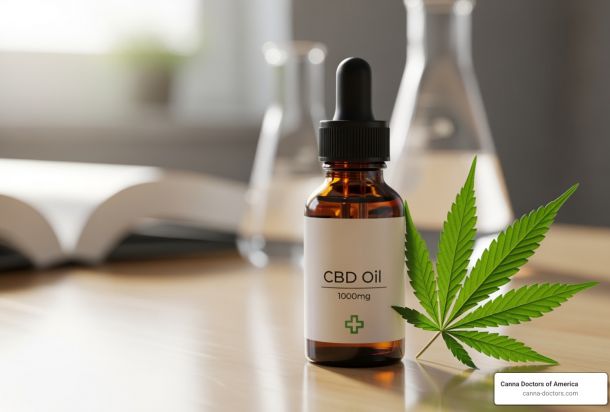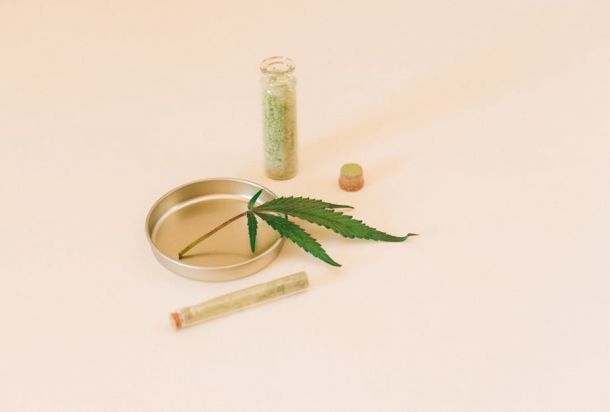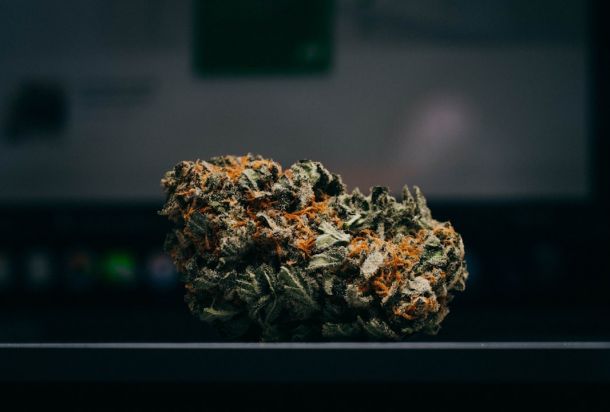Getting Your Medical Marijuana Card: No Stress, Just Steps

Navigating Your Path to Medical Cannabis
Thinking about getting your medical marijuana card but not sure where to start? I get it – the process can seem intimidating at first glance. The good news is that answering the question of how do you get medical marijuanas card is simpler than you might think.
Here’s the journey in a nutshell:
- Confirm eligibility – Verify you have a qualifying medical condition
- Find a certified doctor – Schedule an evaluation (in-person or telemedicine)
- Complete application – Submit required documentation and proof of residency
- Pay state fee – Costs range from $25-100 depending on your state
- Receive approval – Processing times vary from 1-14 business days
The path to relief is actually quite straightforward, though specifics do vary by state. Getting your medical marijuana card is fundamentally a healthcare decisionone that opens the door to cannabis-based treatments that might help where traditional medicines haven’t quite hit the mark.
I’ve seen how this process changes lives. Whether you’re managing chronic pain that keeps you up at night, anxiety that makes daily tasks difficult, PTSD that haunts your thoughts, or any number of qualifying conditions, there’s a clear sequence of steps designed to connect you with potentially life-changing medicine.
Hi there – I’m Geoff Massey, Regional Director at Canna Doctors of America. I’ve had the privilege of guiding thousands of patients through the process of how do you get medical marijuanas card while helping them understand cannabis options custom to their unique health situations. There’s nothing quite like seeing someone find relief after they’ve been struggling for so long.
Looking for more specifics about how do you get medical marijuanas card? We’ve got you covered with these helpful resources:
Let’s dive deeper into each step of this journey so you can move forward with confidence, knowing exactly what to expect along the way.
What Is a Medical Marijuana Card & What Can You Do With It?
A medical marijuana card (often called a “med card” or “cannabis card”) is your official state-issued ID that opens the door to legal cannabis treatment. It’s not just a piece of plastic – it’s your ticket to relief with legal protection behind it.
As Rebecca from Tampa puts it: “My medical card is like a passport to relief. Before getting it, I was always worried about legal issues. Now I can walk into a dispensary confidently, knowing I’m protected under state law.”
When you have your card in hand, you gain several powerful benefits. You receive legal protection from arrest when possessing cannabis within your state’s limits. You get dispensary access to purchase from licensed medical marijuana facilities. Many states offer significant tax savings – sometimes up to 25% less than what recreational users pay. You’ll find higher potency options specifically designed for medical treatment that often exceed what’s available recreationally. Some states even permit home cultivation for card holders, and you typically enjoy higher possession limits than recreational users.
Michael from St. Petersburg shares his experience: “When I first got my card in Florida, I was surprised at how much I saved on taxes compared to what my friends in recreational states were paying. Plus, I can access higher-potency products that actually help my condition.”
Card vs. Recommendation
When asking how do you get medical marijuanas card, it’s important to understand there are actually three different components:
Your physician recommendation/certification is the document your doctor provides stating you have a qualifying condition that could benefit from medical cannabis. In some states, this alone might be enough to purchase from dispensaries.
The medical marijuana ID card is your official state-issued identification. It typically includes your photo, name, ID number, and expiration date – your proof that you’re a legitimate patient.
The state registry is the database where qualified patients are recorded. Your registration in this system is what makes your card valid and provides the legal protection you need.
The specifics vary by state. In Georgia, the Low THC Registry card costs $25 and remains valid for two years, while Massachusetts no longer charges a fee to register through their Cannabis Control Commission.
Benefits at a Glance
Beyond the basics, cardholders enjoy numerous advantages that make the application process worthwhile. You’ll likely pay lower taxes – often 15-25% less per purchase compared to recreational buyers. You’ll have access to stronger potency choices specifically formulated for serious symptom relief. Your card provides crucial legal protection against possession charges (within state limits).
During product shortages, many states ensure priority access for medical patients. Dispensaries frequently offer renewal perks and discounts to patients renewing their cards. And if you’re between 18-21, the age advantage means you can access medical cannabis while recreational use remains limited to those 21 and older.
Understanding these benefits helps explain why so many patients ask how do you get medical marijuanas card – it’s not just about access, but about better options, legal protection, and often significant cost savings over time.
How do you get medical marijuanas card: Step-by-Step Guide
Now let’s break down exactly how do you get medical marijuanas card with a clear, step-by-step approach. While specific requirements vary by state, the general process follows these five key steps:
Step 1 – Confirm Eligibility
Before diving into paperwork, you’ll need to verify you have a qualifying medical condition. Think of this as your ticket to entrywithout a qualifying condition, you can’t board this particular train.
Most states recognize conditions like chronic pain, cancer, epilepsy, multiple sclerosis, Crohn’s disease, PTSD, glaucoma, and HIV/AIDS. Other commonly accepted conditions include Parkinson’s disease, Alzheimer’s, severe nausea, wasting syndrome, and terminal illnesses.
In Florida specifically, the list includes all those mentioned above plus ALS, terminal conditions, and chronic nonmalignant pain. James, a veteran from Clearwater, shared his experience: “When I was diagnosed with PTSD after military service, I didn’t immediately consider medical cannabis. But after traditional medications caused severe side effects, my VA doctor actually suggested I look into the state program. It was life-changing.”
Not sure if your condition qualifies? A preliminary consultation can help clarify whether your symptoms might make you eligible, even if your specific diagnosis isn’t explicitly listed. Many conditions causing chronic pain or severe nausea often qualify.
Check our full list of qualifying conditions
Step 2 – Find a Certified Provider & Get Evaluated
Finding the right doctor is crucial when figuring out how do you get medical marijuanas card. Not just any physician can provide this certificationthey must be registered with your state’s medical marijuana program.
Your evaluation options typically include:
- A traditional in-person office visit
- A telemedicine appointment (available in many states)
- A visit to a specialized medical marijuana evaluation center
During your appointment, expect a comprehensive health discussion. Sarah from Tampa notes, “My evaluation was actually much more thorough than I expected. The doctor spent nearly 30 minutes discussing my chronic migraines, what treatments I’d tried, and how different cannabis options might help. It felt like real healthcare, not just a rubber stamp.”
Be prepared with your government ID, proof of residency, medical records, and a list of current medications. The doctor will review your history, discuss your symptoms, explain potential cannabis benefits for your condition, answer your questions about products and consumption methods, and complete your certification if you qualify.
In Florida, establishing a “bona fide physician-patient relationship” isn’t just bureaucratic jargonit’s required by law. This means your doctor must conduct a physical examination and thoroughly review your medical history before making any recommendations.
Step 3 – Submit Your Application
With your doctor’s certification in hand, it’s time to make things official with your state. Most states now offer online application portals that make this process relatively painless.
Your application will typically require your completed application form, physician certification, proof of residency (like a driver’s license or utility bill), a passport-style photo, the application fee, and caregiver information if that applies to your situation.
Miguel from St. Petersburg was pleasantly surprised by the process: “I was nervous about the application, but the online portal was surprisingly user-friendly. I uploaded my documents on a Friday and had my temporary approval by Monday morning.”
A few quick tips to avoid delays: use a plain background for your photo, double-check that all your documents are clearly legible, make sure your name appears exactly the same across all paperwork, keep copies of everything, and don’t hesitate to follow up if you don’t hear back within the expected timeframe.
In Massachusetts, for example, after getting certified, you’ll receive a PIN to register online with the Cannabis Control Commission. You’ll upload your ID and photo, then wait for approvala process that’s become much more streamlined in recent years.
Step 4 – Pay & Wait for Approval
Now comes the waiting gamebut don’t worry, it’s typically not a long one. State fees and processing times vary widely across the country.
Application fees range from absolutely nothing in Massachusetts to around $75 in Florida. Other examples include Colorado at $29.50, Kentucky at $25, and Oklahoma at $100 (though they offer discounts for Medicaid, Medicare, and disabled veterans).
As for how long you’ll wait, Florida typically processes applications within 10 business days, while Oklahoma may take up to 14 business days (that’s actually mandated by law). Colorado is impressively quick at 1-3 business days for online applications, while Pennsylvania might keep you waiting 2-3 weeks.
The good news? Many states now offer temporary or provisional approval that lets you start shopping at dispensaries while waiting for your physical card to arrive. In Oklahoma, for instance, you’ll receive a digital copy of your license that you can use immediately after approval.
How Long Does It Take to Get a Medical Marijuana Card?
Step 5 – Shop Responsibly & Keep Records
Congratulations! With card in hand, you’re ready to visit dispensaries. For your first visit, bring your medical marijuana card, government-issued photo ID, and cash (many dispensaries can’t accept credit cards due to federal banking restrictions).
Jennifer from Clearwater remembers her first dispensary experience: “My first visit was overwhelmingso many options! But the staff took time to explain different strains and consumption methods. They helped me find a low-THC, high-CBD tincture that works perfectly for my anxiety without making me feel impaired.”
Remember to stay within your state’s possession limits (in Florida, that’s a 70-day supply with a maximum of 2.5 ounces of smokable flower every 35 days), keep your cannabis in its original packaging when transporting, never drive under the influence, store products safely away from children and pets, and mark your renewal dates on your calendar since most cards must be renewed annually.
Keeping your receipts is also smartthey serve as additional proof of legal purchase and help you track what products work best for your condition.
Learn what to bring to a Florida dispensary
Do You Qualify? Eligibility, Fees & Timelines by State
When figuring out how do you get medical marijuanas card, understanding your state’s specific requirements is crucial. Each state has its own:
- List of qualifying conditions
- Application procedures
- Fee structures
- Processing timelines
- Possession limits
Here’s a comparison of several state programs:
| State | Application Fee | Processing Time | Card Validity | Possession Limit |
|---|---|---|---|---|
| Florida | $75 | 10 business days | 1 year | 2.5 oz flower/35 days |
| Oklahoma | $100 ($20 reduced) | 14 business days | 2 years | 3 oz on person, 8 oz at home |
| Colorado | $29.50 | 1-3 business days | 1 year | 2 oz |
| Massachusetts | $0 | 1-2 weeks | 1 year | 10 oz/60-day supply |
| Kentucky | $25 | TBD (program new) | 1 year | 30-day supply |
| Georgia | $25 | 15 business days | 2 years | 20 oz low-THC oil |
| Pennsylvania | Doctor fee only | 2-3 weeks | 1 year | 30-day supply |
Many states offer reduced fees for:
- Veterans
- Medicaid/Medicare recipients
- SSDI beneficiaries
- Low-income patients
In Oklahoma, for example, the standard $100 fee is reduced to $20 for patients on Medicaid, Medicare, or with 100% disabled veteran status. In Colorado, patients may qualify for a fee waiver if their household income is 185% of the Federal Poverty Level or less.
“As a veteran with PTSD, I qualified for the reduced fee in Florida,” shares Robert from Tampa. “The savings might seem small, but when you’re on a fixed income and dealing with medical expenses, every bit helps.”
Special Situations: Minors, Caregivers & Visiting Patients
When it comes to how do you get medical marijuanas card for special situations, the process gets a bit more complex. Whether you’re helping a minor, serving as a caregiver, or traveling between states, there are specific rules you’ll need to steer.
How do you get medical marijuanas card if you’re a minor?
Getting a medical marijuana card for someone under 18 involves extra steps to ensure safety and appropriate use. As a parent or guardian, here’s what you need to know:
Most states require two medical professionals to sign off on a minor’s application. In Massachusetts, for instance, you’ll need certification from two providers, with at least one being a pediatrician or specialist in your child’s condition. This extra layer of review helps ensure medical cannabis is truly appropriate for your young one.
“When my son was diagnosed with severe epilepsy at 12, we’d tried seven different medications with horrible side effects,” shares Teresa from Tampa. “The process to get his card was more involved than for adults, but completely worth it. His seizures have decreased by almost 70% with a high-CBD tincture.”
You’ll also need to provide written consent as the parent or legal guardian. This isn’t just a formality—it acknowledges you understand the treatment and accept responsibility for its administration. In most states, you’ll automatically be designated as your child’s caregiver, meaning you’ll be the only person who can purchase and administer the cannabis.
Be prepared to provide additional documentation, such as birth certificates or guardianship papers, along with more comprehensive medical records than adult patients typically need. Many states also restrict the types of products available to minors, often limiting high-THC options while allowing CBD-dominant formulations.
How do you get medical marijuanas card as a visiting patient?
Traveling with a medical condition doesn’t mean leaving your treatment behind. Many states offer reciprocity—recognizing out-of-state medical marijuana cards—though the specifics vary widely.
If you’re planning a trip to Oklahoma, for example, you can apply for a 30-day temporary license with your home-state card. States like Arkansas, Hawaii, Maine, Nevada, New Hampshire, New Mexico, Rhode Island, Utah, and Washington D.C. also offer some form of reciprocity for out-of-state patients.
Georgia takes a different approach, recognizing out-of-state cards for up to 45 days, but only if your home state allows similar possession and you’ve been in Georgia less than 45 days. It’s a good example of why researching your destination’s specific rules is essential.
“I travel to New Mexico frequently for work, and their reciprocity program is a lifesaver,” explains Jason from St. Petersburg. “I just show my Florida card and ID at the dispensary, and I’m able to purchase what I need. It means I don’t have to choose between traveling for work and managing my chronic pain.”
Important travel tips to remember:
- Never transport cannabis across state lines, even between two legal states—this remains a federal offense
- Always carry your home-state card, government ID, and physician documentation
- Research purchase limits, which are often lower for visiting patients
- Contact dispensaries in advance to confirm they accept out-of-state cards
- Consider products that will last your entire stay to avoid multiple purchases
For caregivers supporting patients across state lines, the rules get even more complex. Some states require background checks for caregivers, even temporary ones, while others may limit the number of patients a caregiver can support. If you’re traveling with someone who needs assistance accessing their medicine, call the state’s cannabis program office directly for guidance.
Staying Legal: Purchase, Possession & Renewal Rules
Getting your medical marijuana card is just the beginning of your journey. Once that official ID is in your hands, you’ll need to steer the rules that keep you on the right side of the law. Think of these guidelines as the “owner’s manual” for your new card.
Let me walk you through what you need to know to stay compliant while enjoying the benefits of your medical cannabis.
Your state determines how much you can have. Each state sets its own possession limits, and they can vary quite a bit:
In Florida, you’re allowed 2.5 ounces of flower every 35 days – about the weight of a small apple. Massachusetts patients can possess up to 10 ounces (a 60-day supply), while Kentucky limits patients to a 30-day supply (specifically 112 grams of raw plant, 28 grams of concentrate, or 3,900 milligrams of THC).
“I keep a calendar on my phone to track my purchases,” shares Melissa from Tampa. “It helps me stay within limits and budget my medicine throughout the month.”
When you’re traveling with your medicine, always keep products in their original, sealed packaging – this is non-negotiable. Store them in your trunk or locked glove compartment while driving, and never, ever cross state lines with any cannabis products, even if you’re traveling between two legal states. And though it might seem obvious, don’t consume in your vehicle, even as a passenger.
What about air travel? This gets tricky. According to our research on traveling with medical marijuana, TSA doesn’t specifically search for marijuana, but if they find it, they’ll refer the matter to local law enforcement. CBD products containing less than 0.3% THC are federally permitted in carry-on luggage, but medical marijuana remains federally illegal regardless of your card status.
“I learned the hard way that having a card doesn’t mean I can fly with my medicine,” admits Robert from Clearwater. “Now I research dispensary options at my destination before traveling.”
Your workplace policies matter too. Even with that official medical card, employers can still enforce drug-free workplace policies. It’s worth checking your company’s stance before using medical cannabis, especially if your job involves safety-sensitive duties like operating heavy machinery or driving.
Don’t let your card expire! Most medical marijuana cards must be renewed annually, and the process takes time. Mark your calendar to start the renewal process 30-45 days before expiration. You’ll typically need a new physician certification, though some states offer streamlined online renewal with reduced fees. If you let your card lapse completely, you might have to start the entire application process over from scratch.
Thomas from Clearwater learned this lesson: “I almost let my card expire, which would have meant starting from scratch. Now I set a reminder 45 days before expiration to schedule my renewal appointment. The renewal process is usually faster and sometimes less expensive than the initial application.”
Life happens – cards get lost, people move. If you lose your card or your information changes, report lost or stolen cards immediately through your state’s portal. Address changes usually need to be updated within 10-14 days. Replacement cards typically cost $10-25, and you should continue using your existing card until the replacement arrives.
For safe and effective use, follow these common-sense dosing guidelines: start with low doses (5-10mg THC), increase gradually to find your optimal dose, and remember that different consumption methods have different onset times and durations. Many patients find it helpful to keep a journal of products, doses, and effects. And always discuss your usage with your certifying physician at follow-up appointments.
How do you get medical marijuanas card is just the beginning – knowing how to use that card responsibly ensures you’ll continue to have access to the medicine you need without legal complications.
Frequently Asked Questions about how do you get medical marijuanas card
Getting your medical marijuana card shouldn’t be complicated, but it’s natural to have questions about the process. Let’s address some of the most common concerns I hear from patients every day.
Is medical marijuana covered by insurance?
The short answer is no, and that surprises many people. Because cannabis remains federally classified as a Schedule I substance, health insurance plans—including Medicare and Medicaid—won’t cover your medical marijuana or related doctor visits. Everything comes out of your pocket, from the initial evaluation (typically $150-300) to the state fees ($0-100) and the actual products.
“I was disappointed when I learned insurance wouldn’t help,” admits Eleanor, a retired teacher from Tampa. “But here’s the silver lining—I’m actually spending less on cannabis than I was on my three prescription medications with their copays. And I feel so much better.”
The good news is that many states offer financial relief through reduced application fees if you’re a veteran, have a low income, or receive disability benefits. Don’t be shy about asking dispensaries about their compassionate care programs too—many offer significant discounts to patients facing financial challenges.
What if I lose my card or my info changes?
Life happens! Cards get lost, people move, and names change. Here’s how to handle these situations:
If your card goes missing, report it immediately through your state’s online portal or by phone. Most states charge a replacement fee between $10-25, but it’s worth it for the peace of mind. In the meantime, some states allow you to use a digital version of your card on your phone—smart to keep a screenshot just in case!
When you move, most states require updating your address within 10-14 days. Massachusetts is particularly strict, requiring updates within just five days for any name, address, or ID changes.
For name changes, you’ll need to submit legal documentation through your state’s portal. And if you switch doctors, you’ll need a fresh certification from your new physician.
“I moved across town and completely forgot to update my address,” shares Jason from Clearwater. “I had trouble at the dispensary until I updated my information online. Now I know better!”
Can I grow my own cannabis with a card?
This is where state laws vary dramatically. While some states accept home cultivation as a patient right, others strictly prohibit it:
Massachusetts patients can grow up to 6 plants (or 12 if multiple patients share a household), while Oklahoma allows 6 mature plants plus 6 seedlings. Colorado permits 6 plants with only 3 flowering at once, and Illinois allows medical patients to grow up to 5 plants.
Unfortunately for Florida patients, home cultivation currently isn’t permitted under state law.
Some states offer “hardship cultivation” provisions if you live far from dispensaries or face financial barriers. In Massachusetts, for instance, you might qualify for Hardship Cultivation registration if you demonstrate financial need, transportation challenges, or live in a remote location.
Michael, who lives in a rural area, finds growing incredibly rewarding: “Growing my own medicine connects me to the healing process. I know exactly what goes into my plants—no pesticides or chemicals—and the cost savings over time are substantial.”
If your state allows home growing, remember to stay within plant count limits, keep your garden secure and away from public view, never sell your homegrown cannabis, and follow all safety regulations. Growing is a responsibility as much as it’s a right.
Conclusion
Navigating the path to your medical marijuana card doesn’t have to feel like a maze. The process of how do you get medical marijuanas card follows a straightforward journey that, while different in each state, generally involves getting a doctor’s certification, submitting your application, and receiving approval.
With proper guidance, most patients complete everything within a few weeks and gain legal access to cannabis products that may provide much-needed relief. I’ve seen countless patients transform their quality of life after finally finding an effective treatment option.
At Canna Doctors of America, we’ve simplified this process for patients throughout Tampa, St. Petersburg, and Clearwater. Our same-day approval approach means you don’t have to wait weeks in pain or discomfort. Our physicians understand the challenges you’re facing and guide you through each step with compassion and expertise.
When considering how do you get medical marijuanas card, remember these essential steps:
First, take time to verify your qualifying condition and gather relevant medical records. This groundwork makes your evaluation go smoothly. Next, collect proof of residency documents—your Florida driver’s license or state ID works perfectly. Then, complete your physician evaluation where a doctor will assess if medical cannabis is appropriate for your condition. After receiving your certification, submit your state application with all required documentation and the $75 fee. Finally, mark your calendar for renewal dates (typically annual) to maintain continuous legal protection.
Medical cannabis has been life-changing for thousands of patients who found little relief from traditional medications. If you’re struggling with chronic pain, anxiety, PTSD, or other qualifying conditions, taking the first step toward getting your card could open the door to a more comfortable, manageable health journey.
Ready to start? Learn more about our simple process or contact us to schedule your evaluation today. We’re here to help you access the relief you deserve with dignity and support.










